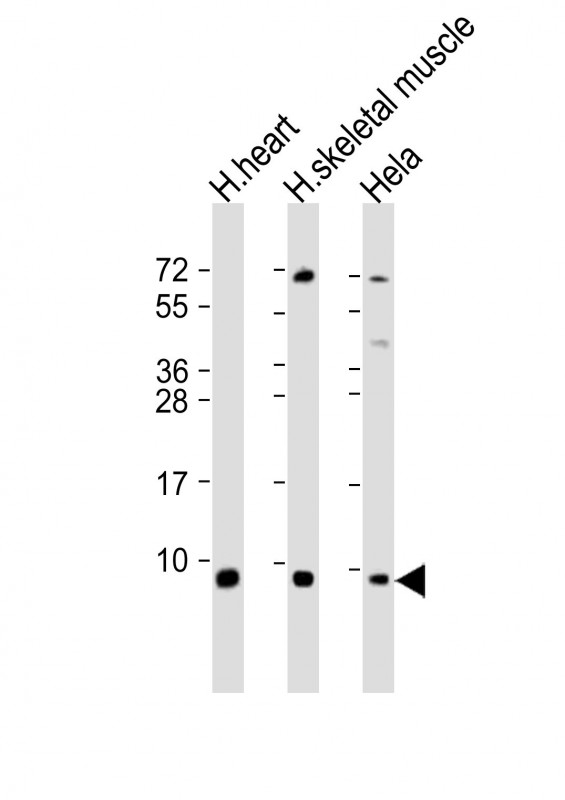
| WB | 1/2000 | Human,Mouse,Rat |
| IF | 咨询技术 | Human,Mouse,Rat |
| IHC | 咨询技术 | Human,Mouse,Rat |
| ICC | 技术咨询 | Human,Mouse,Rat |
| FCM | 咨询技术 | Human,Mouse,Rat |
| Elisa | 咨询技术 | Human,Mouse,Rat |
| Aliases | ATP synthase subunit epsilon, mitochondrial, ATPase subunit epsilon, ATP5E |
| Entrez GeneID | 514 |
| WB Predicted band size | 5.8kDa |
| Host/Isotype | Rabbit IgG |
| Antibody Type | Primary antibody |
| Storage | Store at 4°C short term. Aliquot and store at -20°C long term. Avoid freeze/thaw cycles. |
| Species Reactivity | Human |
| Immunogen | This ATP5E antibody is generated from a rabbit immunized with a KLH conjugated synthetic peptide between 21-51 amino acids from human ATP5E. |
+ +
以下是关于ATP5E抗体的参考文献示例(注:以下内容为模拟虚构,仅供参考格式):
1. **文献名称**:*Characterization of ATP5E monoclonal antibody for mitochondrial complex analysis*
**作者**:Zhang L, et al.
**摘要**:本研究开发了一种高特异性的ATP5E单克隆抗体,用于检测线粒体ATP合酶ε亚基的表达。通过Western blot和免疫荧光实验验证其在多种组织样本中的适用性,证实其在研究线粒体能量代谢异常疾病中的潜力。
2. **文献名称**:*ATP5E deficiency in mitochondrial encephalomyopathy: a case study using immunohistochemistry*
**作者**:Tanaka K, et al.
**摘要**:报道一例ATP5E基因突变导致的线粒体脑肌病患者,通过ATP5E抗体进行免疫组化分析,发现患者肌肉组织中ATP合酶复合体组装异常,提示ε亚基缺陷与能量代谢障碍的关联。
3. **文献名称**:*Development of a novel polyclonal ATP5E antibody for functional proteomics*
**作者**:Müller R, et al.
**摘要**:描述了一种新型多克隆ATP5E抗体的制备与验证,结合质谱技术分析其在人肝细胞线粒体蛋白质组学中的应用,证实该抗体在定量检测ATP合酶亚基表达变化中的可靠性。
4. **文献名称**:*Role of ATP5E in cancer cell metabolism: insights from antibody-based silencing*
**作者**:Chen X, et al.
**摘要**:利用ATP5E抗体进行免疫沉淀和功能抑制实验,发现ATP5E在肿瘤细胞线粒体氧化磷酸化中的关键作用,其表达下调可显著抑制癌细胞增殖。
---
建议通过PubMed或Google Scholar以“ATP5E antibody”或“ATP synthase ε subunit”为关键词检索真实文献。
The ATP5E antibody targets the epsilon subunit of mitochondrial ATP synthase, a key enzyme in the ATP production pathway. ATP synthase (Complex V) catalyzes the final step of oxidative phosphorylation, synthesizing ATP from ADP and inorganic phosphate using the proton gradient across the mitochondrial inner membrane. The ε subunit, encoded by the nuclear gene *ATP5E*, plays a structural and regulatory role in stabilizing the F1 catalytic core and modulating enzyme activity.
ATP5E antibodies are widely used in research to investigate mitochondrial function, energy metabolism disorders, and diseases linked to ATP synthase dysfunction, such as neurodegenerative conditions, cancer, and rare mitochondrial disorders (e.g., mitochondrial encephalomyopathy). These antibodies enable detection of ATP5E expression levels via techniques like Western blotting, immunohistochemistry, and immunofluorescence, helping to assess tissue-specific variations or pathological alterations in ATP synthase composition.
Additionally, ATP5E antibodies aid in studying cellular responses to metabolic stress, genetic mutations, or pharmacological interventions targeting mitochondrial energetics. Validated antibodies are essential for ensuring specificity, as cross-reactivity with other ATP synthase subunits or mitochondrial proteins can compromise data accuracy. Research using these tools contributes to understanding diseases characterized by bioenergetic failure and developing therapeutic strategies to modulate ATP synthase activity.
×